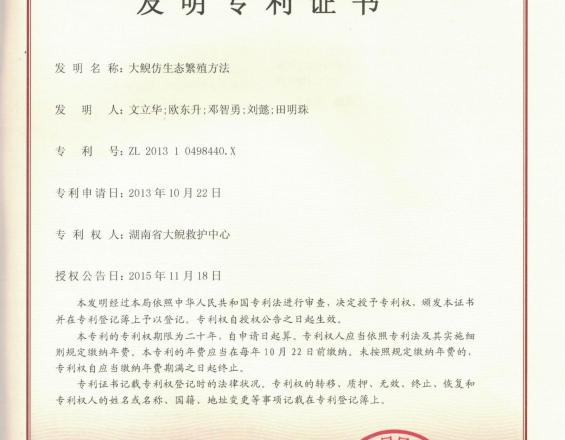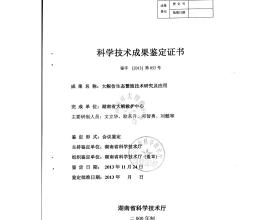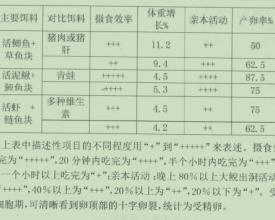Chinese Giant Salamander Conservation and Population Restoration Techniques

A method for ecological breeding of giant salamanders includes establishing an environment mimicking their natural habitat, selecting and nurturing broodstock, artificial ovulation induction, insemination, incubation, and seedling rearing. This involves creating a model based on the natural habitat's ecological and water factors to determine optimal construction parameters for streams and caves, ensuring ideal living conditions. Selective breeding in these environments promotes natural reproduction and dietary trials to establish the best nutritional plans, enhancing male sperm quality and female egg-bearing capacity.
Context
Challenges addressed
The Chinese giant salamander, unique to China, is a second-class protected species found across 17 provinces, municipalities, and autonomous regions. Since the 1970s, systematic research has yielded significant outcomes. Yet, advancements in breeding techniques are still needed.
Wild salamanders face challenges from environmental degradation and poaching, leading to declining numbers. They also have low reproductive rates, with slow growth, late maturity, and low survival and breeding rates, exacerbating the population decline. The loss of wild genetic resources poses a severe challenge to breeding research and artificial cultivation.
This project mimics the giant salamander's natural habitat, building a 916 sq m ecological pond and a 500 sq m hatching room, achieving 68.75% pairing, 93.5% fertilization, and 99% survival rates. It boosts breeding output to 20,000, worth about 3.6 million yuan.
Location
Process
Summary of the process
Establishing an ecological breeding environment is crucial for the artificial cultivation of the giant salamander, as it is a prerequisite for successful subsequent breeding efforts. By constructing a model of ecological breeding environment factors and determining the optimal living space for the giant salamander, its natural habitat can be effectively simulated. To achieve the growth of the giant salamander population and the preservation of genetic diversity, we must overcome the challenges of breeding the species in artificial environments and restore its natural survival characteristics. Compared to past practical experience, it is known that under non-ecological artificial breeding conditions, the giant salamander may exhibit poor appetite, frequent illnesses, low breeding pair formation rates, and low juvenile survival rates. Therefore, this approach holds significant value for problem-solving and achieving goals.
Building Blocks
Breeding area mimicking wild habitat environment
Addressing the existing technical challenges, namely the differences between ecological breeding environments and wild habitats, and the low natural reproductive capacity of the giant salamander, characterized by slow growth, late sexual maturity, and low survival and breeding rates. A method for ecological breeding suitable for the giant salamander, based on the environmental factors of its natural habitat, is provided.
Enabling factors
The ecological imitation environment is established based on the ecological and environmental factors of the giant salamander's natural habitat, and the selection of the reference object for this ecological environmental factor model is crucial.
After long-term research and discussions among scholars, we have established an environmental factor model based on geographical and climatic factors, river section influence factors, cave environmental factors, and water environmental factors. Based on this model, we have established the best construction parameter system for "ecological stream ditches" and "caves." For example, the surface vegetation coverage of the cave area on both sides of the ecological stream ditch should be greater than 85%; the stream ditch should be constructed in an irregular shape, with a gradient of 30° to 45° extending into the stream, a width of 50 to 300 cm, a depth of 50 cm, and a stream bed covered with a 15 to 20 cm thick layer of sand and pebbles composed of river sand and pebbles, a stream water depth of 25 to 30 cm, and a flow rate of 0.05 to 1 m/s; the cave area ratio should be ≥1.5, and other specific parameter requirements.
Breeding and Husbandry Techniques for the Chinese Giant Salamander (Andrias davidianus)
Breeding technology for broodstock selection involves choosing individuals of different sexes and origins from the same region as parents. The feed suitable for breeding should be diversified, mainly consisting of feed that is high in protein, low in fat, low in calories, and rich in trace elements. One month before and after the breeding period, feed that is high in protein, high in fat, and high in calories should be provided.
Feed selection and proportioning experiments involve feeding different aquaculture ponds with different feeds, and conducting trials with different combinations to determine the optimal feed plan and the best nutritional structure for the ecological breeding of the giant salamander. By mastering the most suitable feed and nutritional combination for different periods of the giant salamander, the sperm quality of male broodstock can be improved, and the egg-bearing capacity of female broodstock can be increased.
Enabling factors
Essential factors:
1. Avoid inbreeding. Selecting parents of different sexes and origins from the same region can effectively prevent inbreeding;
2. Choice of feed. Choose feeds that are more easily obtained and have comprehensive nutritional components, such as grass carp, silver carp, loach, shrimp, frogs, pork, and pig liver, etc.
3. Feed processing. Live fish should be freshly killed, and inedible parts such as heads, bones, and spines should be removed; pork and other meats should have fat (if any) removed and cut into long strips weighing about 50 to 100 grams. Dead bait should be soaked in a 30% saltwater solution for 10 minutes; live bait should be soaked in a 2-3 ppm chlorine dioxide solution for 10 minutes.
4. Feeding of feed. Feed should be provided on a regular schedule, with consistent quality, and in fixed quantities. Dead bait should be offered every three days, around 6 pm, with the standard that it should be consumed within one hour. Live bait should be fed at 5% of the total weight of the giant salamanders in each area, with discretion to increase the amount as appropriate.
Lesson learned
By recording the feeding, weight gain, activity, ovulation, and fertilization of the giant salamander (see attached figures). It was found that Group B had a significantly higher feeding efficiency than the other two groups, indicating that the giant salamander will turn to dead bait with lower predation difficulty when hunting live prey is challenging. Data from Group A show that the giant salamander gains weight quickly when fed a diet high in protein and fat for a long period, but has a low ovulation and fertilization rate. In combination with the analysis of the main nutritional components of various baits, it is suitable for the giant salamander's bait to be diversified, mainly consisting of baits that are high in protein, low in fat, low in calories, and rich in trace elements, such as various fish, loach, shrimp, crabs, frogs, etc. One month before and after the breeding period, appropriately high protein, high fat, and high calorie foods can be fed, such as various fish and poultry meat and internal organs, which is beneficial for the giant salamander to accumulate energy before breeding and to recover and overwinter after breeding.
Impacts
Direct economic benefits and social significance: The ecological breeding of the giant salamander is an artificial creation of an environment that simulates natural ecological conditions, allowing scientifically selected giant salamanders to breed on their own in this environment. This is a model for the domestication and breeding of giant salamanders. Compared to artificial domestication and breeding of giant salamanders, this model has the advantages of simple operation, low cost, strong replicability, low technical requirements, no damage to the breeding fish, and significantly increased ovulation rates, fertilization rates, and hatching rates. It has the merits of low investment, quick returns, and is suitable for large-scale promotion.
Promotion and application prospects:
This achievement can be widely promoted and applied in impoverished mountainous areas, as these places have abundant water resources, excellent water quality, and a lot of idle gullies and land. The implementation of this achievement requires little investment and the technology is easy to learn, making it suitable for poverty-stricken areas to become prosperous and wealthy.
Beneficiaries
Mountain dwellers: New income from salamander breeding.
Eco-tourism: Boost revenue with nature breeding sites.
Fisheries: New growth from salamander breeding.
Research: Advances in breeding tech.
Governments: More tax, economic growth.
Environment, Catering, Pharma


